Several dried herbs can create stunning natural colors in your handmade soaps. You'll get rich purples from alkanet root, pinks and reds from madder root, bright yellows from turmeric, and warm oranges from annatto seeds. Calendula petals maintain their yellow vibrancy even in soap's high pH environment. Start with 1-2 tablespoons of crushed herbs per cup of oil for infusion, adjusting concentration for desired intensity. These natural colorants open up a world of creative soap-making possibilities.
Essential Dried Herbs for Natural Soap Coloring
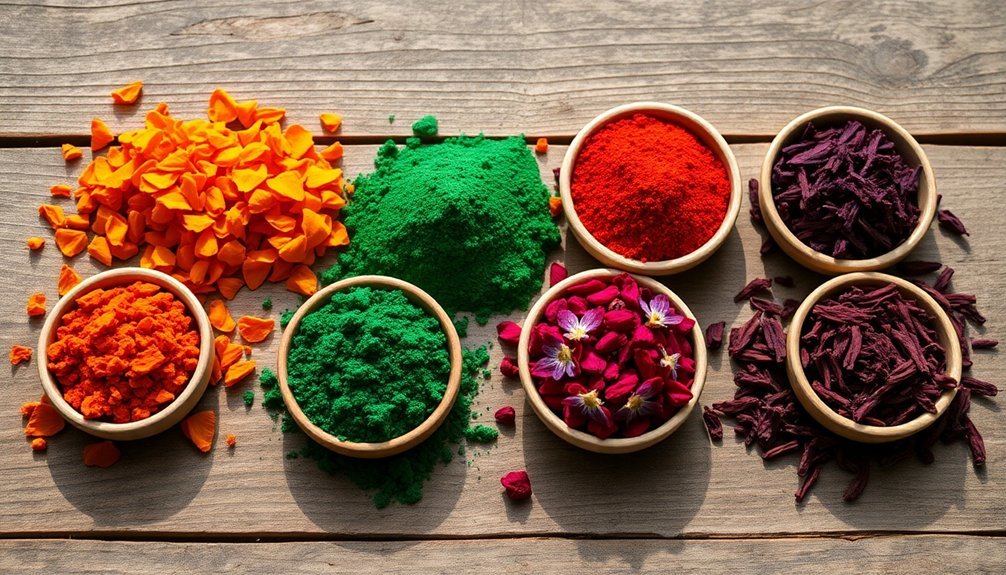
When crafting naturally-colored soaps, dried herbs offer an extensive palette of stunning hues without synthetic additives.
You'll find alkanet root perfect for achieving rich purple tones that deepen during saponification, while madder root delivers beautiful pink to red shades when used in higher concentrations.
For warm colors, you can't go wrong with turmeric and annatto seeds in your soap recipes.
Turmeric creates bright yellow soap through infused oils, while annatto seeds provide a vibrant orange that adds warmth to your creations.
Infuse your soaps with the golden glow of turmeric or the warm sunset hues of annatto for naturally radiant bars.
Don't overlook calendula petals – they're particularly valuable among natural colorants because they maintain their yellow vibrancy in high pH environments.
These dried herbs not only create vibrant soap colors but also contribute potential skin benefits, making them ideal choices for your natural soap making journey.
Preparing and Processing Herbs for Color Extraction
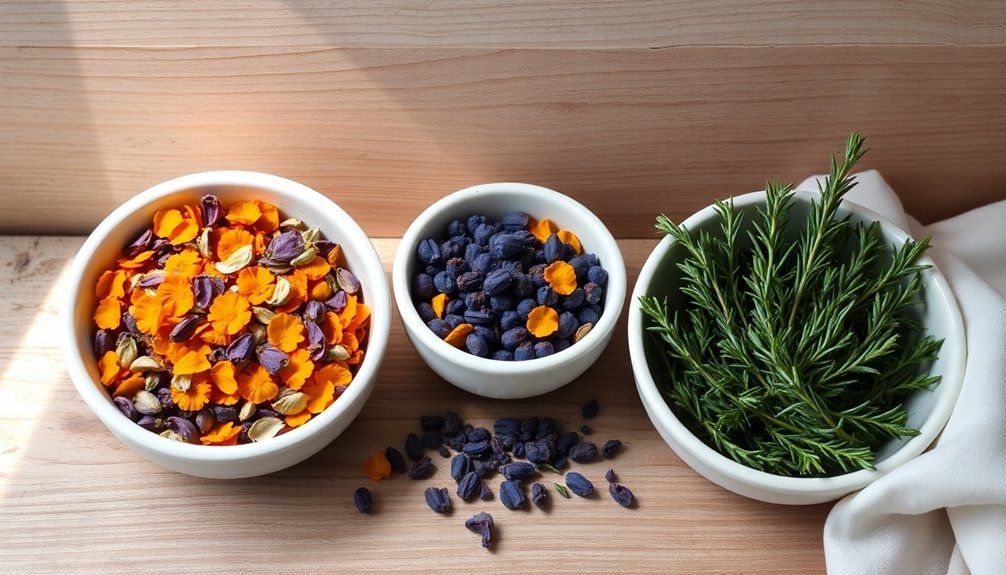
Preparing dried herbs for color extraction requires careful attention to detail to achieve vibrant, consistent results in your soap making. Before you begin processing, make sure your herbs are completely dry to prevent any moisture-related issues during infusion.
Start by crushing or gently pulsing your dried herbs to enhance color release without over-pulverizing them. You'll want to use 1-2 tablespoons of herbs per cup of oil for ideal color extraction.
Choose between two infusion methods: cold processing, where you'll let herbs steep for 2-6 weeks, or heat methods, which involve gently warming the herbs in oil for several hours.
Don't forget to strain your infused oil thoroughly before incorporating it into your soap. This vital step removes herb particles and guarantees your final product has a smooth, professional texture.
Herb-to-Oil Ratios and Infusion Methods
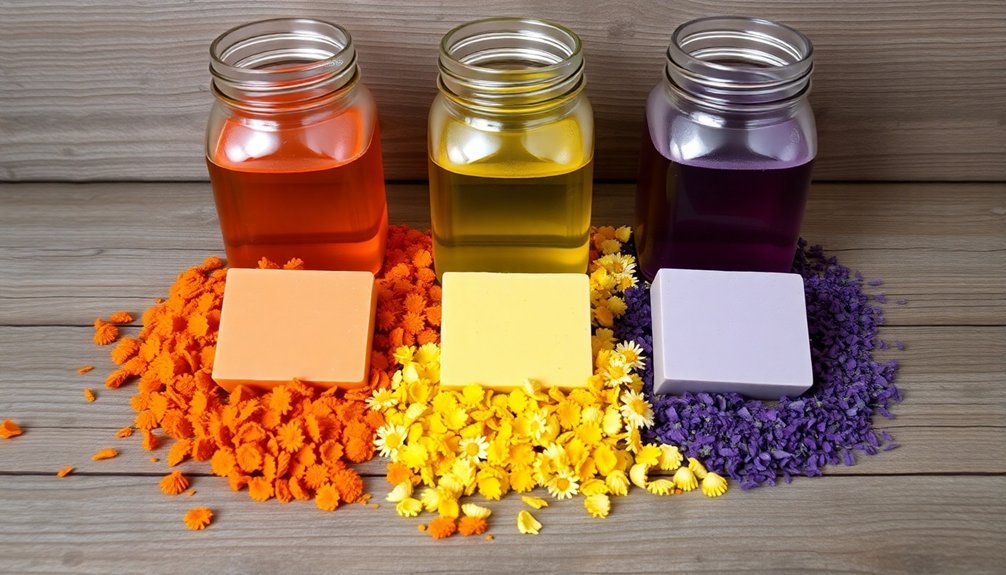
You'll want to start your herbal infusion with 1-2 tablespoons of crushed dried herbs per cup of oil, ensuring complete dryness to prevent spoilage.
For cold infusions, let your herbs steep in oil for 2-6 weeks, or speed up the process using gentle heat for 2-6 hours.
Select your oil based on its natural shelf life and soap-making properties, as both factors will impact the quality and longevity of your infused colorant.
Optimal Infusion Time Periods
The success of herb-infused soap colors depends largely on achieving the right balance between infusion time and herb concentration.
You'll find two primary methods for creating vibrant colors: cold infusion, which takes 2-6 weeks, and heat infusion, requiring only 2-6 hours.
For ideal infusion time, start with 2 tablespoons of powdered herbs per 5 ounces of oil. If you're seeking deep color intensity, increase the infusion concentration up to 40%, especially for herbs like madder root.
When using heat-sealable tea bags, steep your powdered herbs for about two hours to achieve rich soap colors without sediment.
Keep an eye on your infused oil after cooling – darker shades might need additional heating or extended infusion periods, particularly when working with alkanet or turmeric.
Oil Selection Guidelines
Selecting suitable carrier oils forms the foundation for successful herb infusions in soap making. You'll want to start with 1-2 tablespoons of dried herbs per cup of oil for ideal color intensity. When you're creating infused oils, you've got two methods to choose from: cold infusion taking 2-6 weeks, or heat infusion completed in 2-6 hours.
| Herb Type | Ratio (herb:oil) | Infusion Method |
|---|---|---|
| Basic Herbs | 1-2 tbsp/cup | Cold or Heat |
| Madder Root | Up to 40% | Heat Preferred |
| Alkanet | 2-3 tbsp/cup | Cold Preferred |
| Turmeric | 1-2 tbsp/cup | Either Method |
| Strong Herbs | 2-4 tbsp/cup | Cold Preferred |
Remember to strain your infused oil thoroughly before soap making to prevent graininess. For vibrant colors, you may need to adjust herb-to-oil ratios, especially with potent colorants like madder root.
Herb Processing Best Practices
Proper herb processing makes all the difference in achieving consistent, vibrant soap colors. When infusing indigo or other dried herbs, you'll want to use 1-2 tablespoons per cup of oil used. Before starting, confirm your herbs are completely dry to prevent moisture-related mold growth during infusion.
Begin your herb processing by crushing or finely chopping the dried herbs to enhance color extraction.
You've got two infusion options: cold infusion, which takes 2-6 weeks, or heat infusion, which speeds up the process to 2-6 hours. Monitor your mixture's desired color intensity throughout the process. If you're not getting the vibrancy you want, extend the steeping time for cold infusions or apply additional heat for warm infusions.
For ideal color extraction, avoid pulverizing herbs into fine particles that could affect your soap's texture.
Color Combinations and Layering Techniques
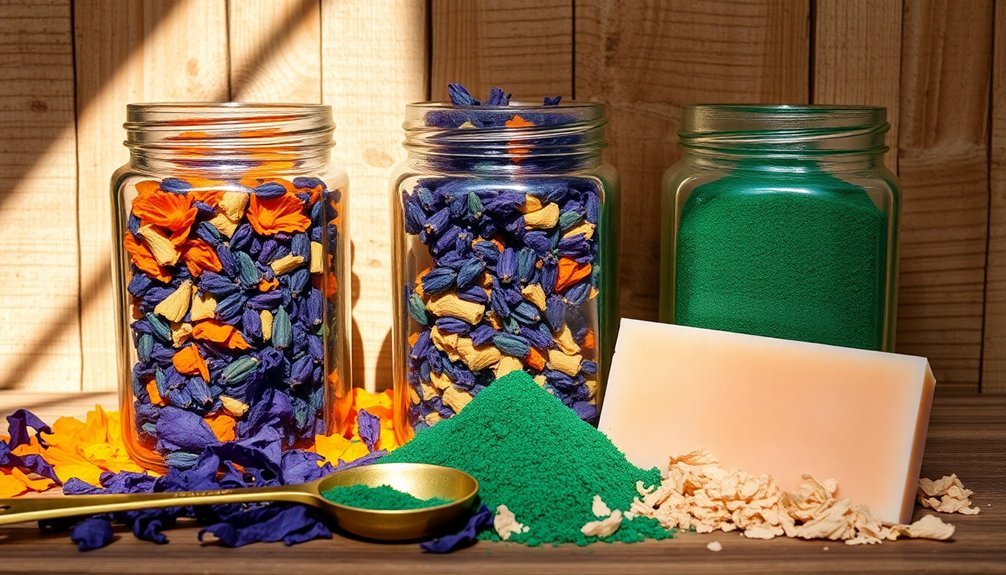
Creating stunning color combinations in natural soap making requires careful attention to both color depth and layering techniques.
You'll achieve the most vibrant colors by strategically pairing natural colorants, such as combining annatto's orange tones with alkanet root's deep purple hues.
When crafting gradient effects, start with lighter infused oils like turmeric or calendula for your base layer. Then, gradually build up to darker shades using madder root for pink or red tones.
It's crucial to let each layer set completely before adding the next. You can create unique colors by experimenting with combinations – try mixing turmeric and madder root for a lovely peach shade.
Always test your color combinations in small batches first, as the saponification process can affect how these natural colorants interact and appear in your final product.
Shelf Life and Color Stability of Herbal Soaps
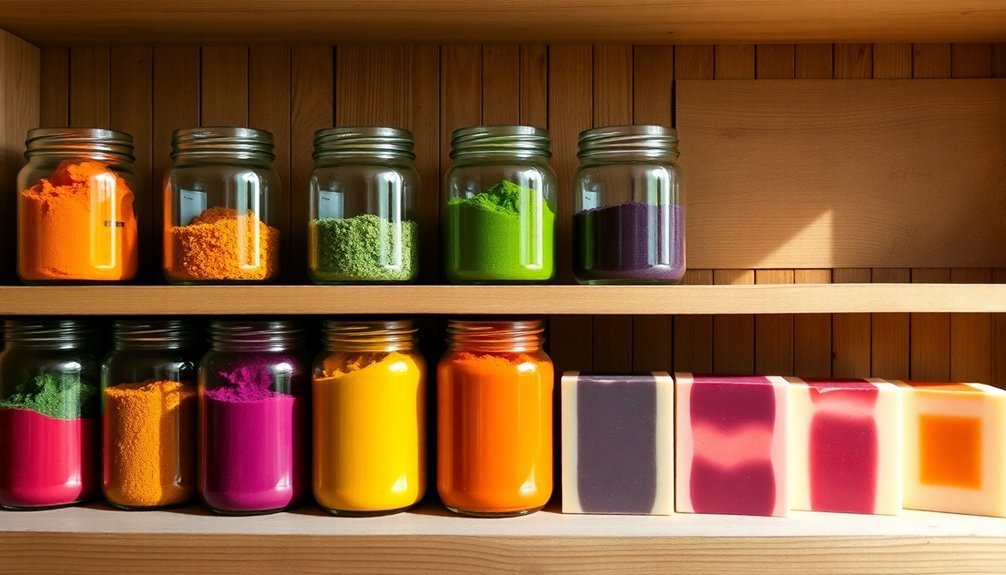
When you're working with herbal soaps, you'll notice that colors naturally evolve over time, with some herbs fading faster than others due to light exposure and pH interactions.
You can extend your soap's color vibrancy by choosing infused oils over fresh herbs, as these offer better stability and longevity in the final product.
To preserve the natural hues in your herbal soaps, store them in a cool, dark place and consider using dried herbs that have been properly stored for up to six months before incorporation.
Color Changes Over Time
Natural colorants in herbal soaps tell an evolving story, as their vibrant hues gradually transform over time.
You'll notice that different herbs respond uniquely to exposure, with some maintaining their stability better than others. While calendula tends to hold its color well, other herbs may fade or change during saponification.
You can minimize color degradation by choosing infused oils over powdered herbs, as they'll provide more consistent results.
When you're working with natural colorants, proper storage becomes essential – keep your soaps in a cool, dark place to preserve their vibrancy.
It's worth testing small batches regularly to understand how your chosen herbs behave over time.
Remember that each batch might perform differently, so you'll want to document your results to perfect your herbal soap coloring technique.
Natural Preservation Methods
To maximize the longevity of your herbal soap colors, proper preservation methods play a key role alongside storage techniques. You'll find that natural preservation methods considerably extend your herbal soaps' shelf life when you incorporate dried herbs with strong antioxidant properties, like rosemary and calendula.
| Preservation Method | Benefits | Best Practices |
|---|---|---|
| Infusing oils | Maintains vibrant colors | Use completely dried herbs |
| Natural preservatives | Extends shelf life | Add dried rosemary/calendula |
| Proper drying | Prevents mold and spoilage | Dry plant materials thoroughly |
To protect your soaps from color degradation, store them away from direct light exposure in opaque containers. When you're working with plant materials, verify they're completely dry before adding them to your soap mixture. You'll get better results by infusing oils with dried herbs rather than adding powdered herbs directly.
Troubleshooting Common Herb Coloring Issues
Struggling with uneven colors or unexpected hues in your herb-colored soaps? You'll need to address common herb coloring issues to achieve consistent results.
First, verify you're using finely powdered dried herbs to prevent graininess and speckling in your final product.
To enhance color intensity, try infusing oils with your herbs before adding them to your soap mixture. This method works particularly well with turmeric, which creates a vibrant yellow when properly processed.
Infusing herbs in oils before soapmaking intensifies natural colors, especially with turmeric's rich golden hues in the final product.
Be aware that some herbs, like alkanet root, can change color during the saponification process, so always test small batches first.
If you're working with delicate herbs like chamomile or lavender, avoid adding them directly to your soap batter.
Instead, use infused oils or wait until after curing to incorporate them, preventing unwanted browning and maintaining your desired hue.
Frequently Asked Questions
What Herbs Are Good for Coloring Soap?
You'll get vibrant colors using alkanet root for purple, madder root for pink, turmeric for yellow, annatto seeds for orange, and calendula petals for yellow. They're all great natural options for soap making.
How Do You Make Vibrant Colors in Soap?
You'll get vibrant soap colors by infusing oils with natural colorants, using up to 5% of total weight. Let your infusions steep for several weeks and test small batches to guarantee you achieve your desired hues.
What Dried Herbs Can You Put in Soap?
You can add calendula petals, madder root, alkanet root, turmeric, and annatto seeds to your soap. They'll create beautiful natural colors while also adding visual interest to your handmade soap creations.
How to Make Natural Colors for Soap?
You'll get natural soap colors by infusing oils with herbs or spices. Mix 1-2 tablespoons per cup of oil. Try turmeric for yellow, madder root for pink, and alkanet root for purple shades.
In Summary
You've now got the knowledge to create beautifully colored soaps using dried herbs from your garden or local supplier. Remember to store your herbs properly, test your infusions before full batches, and document your successful combinations. Don't be afraid to experiment with different ratios and layering techniques. With practice, you'll master the art of natural soap coloring and create unique, vibrant bars that'll impress everyone.

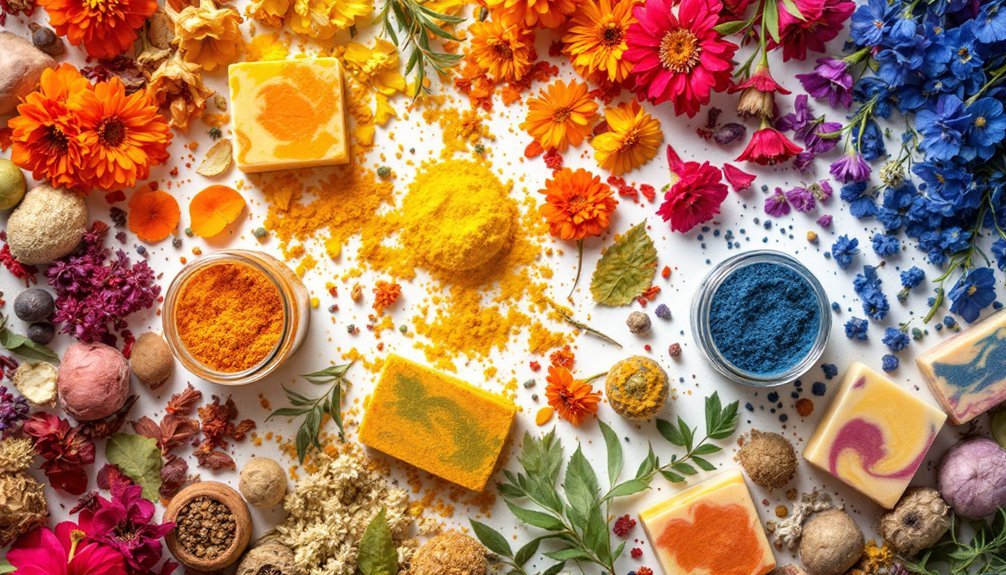



Leave a Reply